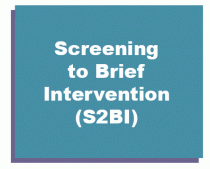NIDA Launches Two Brief Online Validated Adolescent Substance Use Screening Tools
NIDA has launched two brief online screening tools that providers can use to assess for substance use disorder (SUD) risk among adolescents 12-17 years old. With the American Academy of Pediatrics recommending universal screening in pediatric primary care settings, these tools help providers quickly and easily introduce brief, evidence-based screenings into their clinical practices.
Two Screening Options: Providers can select the tool that makes sense for their clinical practice.
The BSTAD and S2BI ask patients about frequency of past year use and triage them into one of three levels of substance use disorder risk: no reported use, lower risk and higher risk. But how are these tools different? How can providers choose which one to use? In the short video below, Dr. Geetha Subramaniam from the National Institute on Drug Abuse discusses just that. She also explains the difference between universal and targeted screening, and shares information about considerations for confidentiality among teen patients.
NIDA has launched two brief online screening tools that providers can use to assess for substance use disorder (SUD) risk among adolescents 12-17 years old. With the American Academy of Pediatrics recommending universal screening in pediatric primary care settings, these tools help providers quickly and easily introduce brief, evidence-based screenings into their clinical practices.
- Brief: BSTAD and S2BI can be administered in less than two minutes.
- Scientifically validated: BSTAD and S2BI were validated in adolescent samples, demonstrating accuracy in identifying adolescents with and without substance use disorders who were seen in pediatric primary care settings.
- Easy administration: BSTAD and S2BI can be self-administered or provider administered using a tablet or computer. Providers are encouraged to consider patient self-administration to save time.
- Follow-up: In addition to the risk score, clinicians receive information about the score’s implications, suggested actions and additional resources that were compiled through subject matter expert consensus.
- Rationale and Benefits of Screening: Substance use during adolescence can result in negative consequences including involvement with the criminal justice system, poor school performance, and health and mental health issues. Nearly 20 percent of adolescents report alcohol use in the past month.1 The prevalence of marijuana use among 8th, 10, and 12th graders (combined) in 2016 was nearly 23 percent.2 Introducing screening into practice can:
- Normalize discussions with adolescents about substance use
- Reinforce and promote healthy behaviors and choices
- Identify adolescents who are potentially at risk for SUD
- Guide brief interventions and referrals for treatment
References
- Kelly, S. M., Gryczynski, J., Mitchell, S. G., Kirk, A., O’Grady, K. E., & Schwartz, R. P. (2014). Validity of brief screening instrument for adolescent tobacco, alcohol, and drug use. Pediatrics, 133(5), 819-826.
- Levy, S., Weiss, R., Sherritt, L., Ziemnik, R., Spalding, A., Van Hook, S., & Shrier, L. A. (2014). An electronic screen for triaging adolescent substance use by risk levels. JAMA Pediatrics, 168(9), 822-828.



